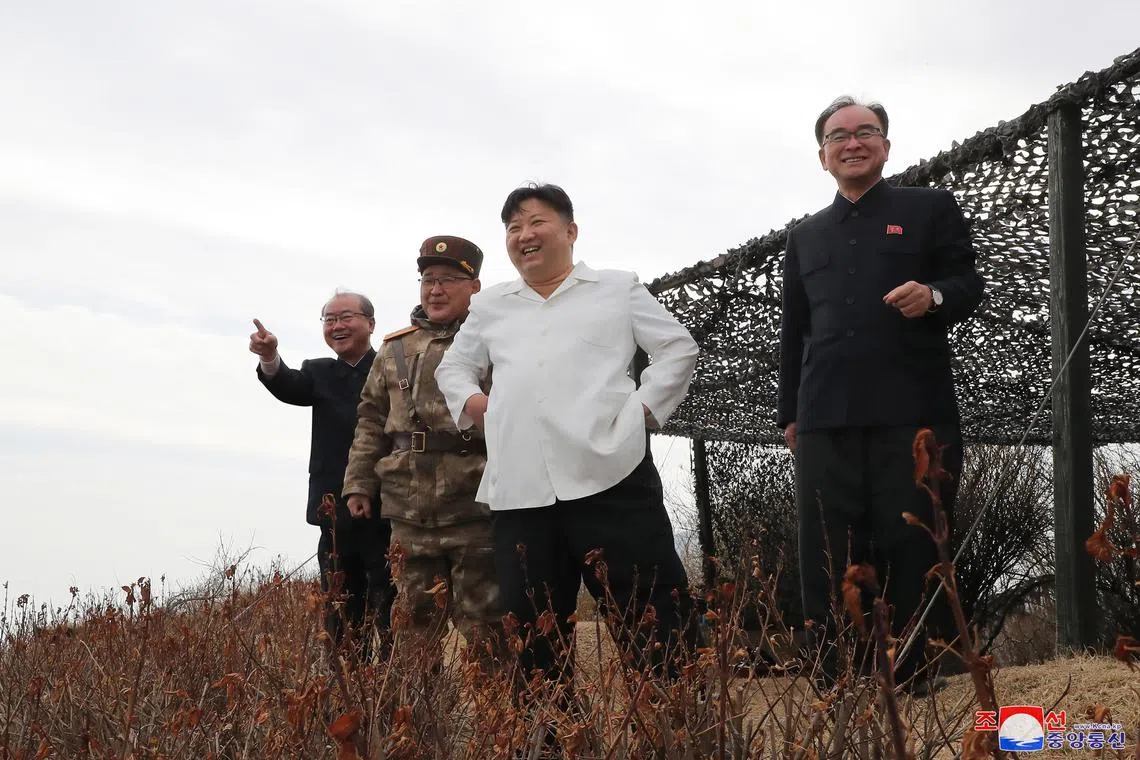North Korea unveils new nuclear warheads as US aircraft carrier arrives in South Korea
Sign up now: Get insights on Asia's fast-moving developments

Mr Kim Jong Un observing a cruise missile exercise conducted in Jakdo-dong, South Hamgyong province, North Korea, on March 22, 2023.
PHOTO: EPA-EFE
Follow topic:
SEOUL – North Korea unveiled new, smaller nuclear warheads and vowed to produce more weapons-grade nuclear material to expand the country’s arsenal, state media Korean Central News Agency (KCNA) said on Tuesday, as a US aircraft carrier arrived in South Korea for military drills.
KCNA released photos of the warheads, dubbed Hwasan-31, as leader Kim Jong Un visited the Nuclear Weapons Institute in Pyongyang, where he inspected new tactical nuclear weapons and technology for mounting warheads on ballistic missiles, as well as nuclear counter-attack operation plans.
Experts say the images could indicate progress in miniaturising warheads that are powerful yet small enough to mount on intercontinental ballistic missiles capable of striking the US.
“It has something more powerful in a smaller space... That’s worrisome,” said Professor Emeritus Kune Y. Suh of Seoul National University’s nuclear engineering department, comparing the new warheads with the 2016 version.
Mr Kim Dong-yup, a former South Korean naval officer who teaches at Kyungnam University, said the warheads were most likely designed for use with at least eight different delivery platforms, including missiles and submarines.
“Those are not limited to tactical missiles but appear to be a miniaturised, lightweight and standardised warhead that can mount on various vehicles,” he said.
“Now that the delivery vehicles are nearly ready, they would churn out warheads to secure second strike capabilities – perhaps hundreds, not dozens – while running centrifuges even harder to get weapons-grade nuclear material.”
Mr Kim Jong Un ordered the production of weapons-grade materials in a “far-sighted way” to boost the North’s nuclear arsenal “exponentially” and produce powerful weapons, KCNA said.
He said the enemy of the country’s nuclear forces is not a specific state or group but “war and nuclear disaster themselves”, and the policy of expanding North Korea’s arsenal is solely aimed at defending the country, and regional peace and stability, according to the media.
Mr Kim was also briefed on an information technology-based integrated nuclear weapon management system called Haekbangashoe, which means “nuclear trigger”, whose accuracy, reliability and security were verified during recent drills simulating a nuclear counter-attack, KCNA said.
North Korea has been ramping up military tests, firing short-range ballistic missiles on Monday and conducting a nuclear counter-attack simulation last week against the United States and South Korea.
The North Korean military simulated a nuclear air explosion strike with two ground-to-ground tactical ballistic missiles during Monday’s firing training, KCNA said in a separate dispatch.
The underwater drone, called Haeil-1, reached a target in the waters off the north-east coast after cruising along a “jagged and oval” 600km course for more than 41 hours, it said.
South Korean President Yoon Suk-yeol said North Korea does not deserve “a single penny” of economic aid while pushing for nuclear development, his spokesman said.
A South Korean military spokesman said that additional tests and analysis would be needed to verify whether the North’s new warheads are deployable, but that its report on the underwater drone was most likely “exaggerated and fabricated”.
Also on Tuesday, a US carrier strike group led by the USS Nimitz docked at the Busan naval base in South Korea after conducting joint maritime drills.
It was the carrier’s first visit to South Korea in nearly six years and coincides with the 70th anniversary of the two countries’ alliance.
Rear-Admiral Kim Ji-hoon of the South Korean navy said joint exercises were intended to improve US extended deterrence – the capability of the US military, especially its nuclear forces, to deter attacks on its allies – given the North’s evolving threats.
The strike group commander, Rear-Admiral Christopher Sweeney, said his ships were prepared for any contingency.
“We don’t seek conflicts with the DPRK. We seek peace and security. We’re not going to be coerced, we’re not going to be bullied, and we’re not going anywhere,” he told reporters.
DPRK refers to North Korea’s official name, the Democratic People’s Republic of Korea.
Pyongyang has accused the allies of stoking tensions and using exercises to rehearse an invasion.
A commentary in the Rodong Sinmun, the media outlet for the North’s ruling party, said the drills, especially those involving the aircraft carrier, amount to “an open declaration of war” and preparations for a “pre-emptive attack” against North Korea.
“The frantic war drills in the puppet region are not just military drills but nuclear war drills for a pre-emptive strike... pursuant to the US political and military option to escalate confrontation with the DPRK and finally lead to a war,” it said. REUTERS

